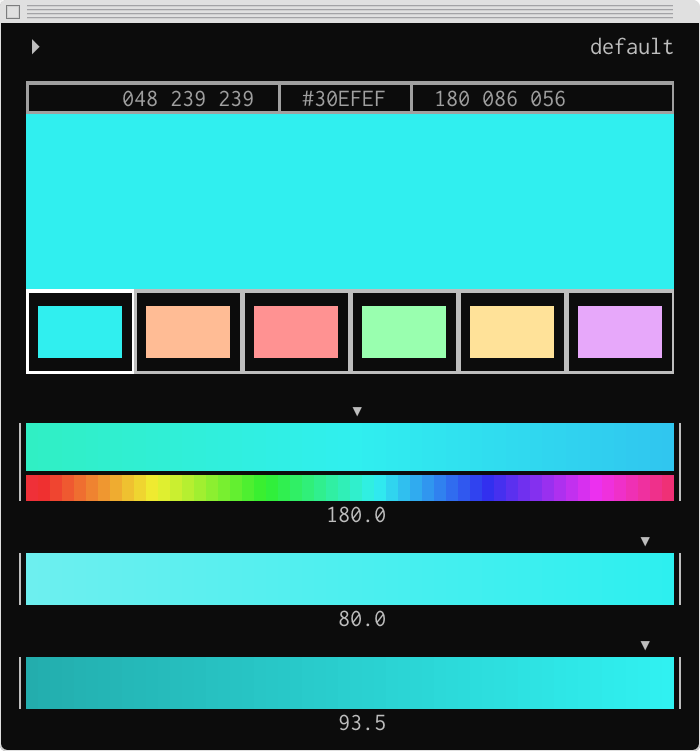Commandline color picker and palette builder
tcolors is a commandline application for creating palettes of one or more colors in HSV space. Created palettes and their colors may be output in several different formats for import and use into other programs.
Colors are imported from, and changes automatically saved to, a human-readable TOML format file.
Go get with:
go install github.com/bcicen/tcolors@latestOr download the latest release for your platform:
curl -Lo tcolors https://github.com/bcicen/tcolors/releases/download/v0.3.2/tcolors-0.3.2-$(uname -s)-amd64
chmod +x tcolors
sudo mv tcolors /usr/local/bin/tcolors is also available for Arch in the AUR
docker run --rm -ti --name=tcolors \
quay.io/vektorlab/tcolors:latestSimply run tcolors to view and modify the default palette. Changes are automatically saved and will persist across sessions.
| Key | Description |
|---|---|
↑, k |
navigate up |
↓, j |
navigate down |
←, h |
decrease selected value |
→, l |
increase selected value |
<shift> + ←/→/h/l |
more quickly increase/decrease selected value |
a, <ins> |
add a new palette color |
x, <del> |
remove the selected palette color |
q, <esc> |
exit tcolors |
? |
show help menu |
To create a new palette or use a specific palette, use the -f option:
tcolors -f logo-palette.tomlPalette colors are stored in a human-readable TOML format and all changes are saved on exit.
In addition to a stored TOML palette file, tcolors provides several output options for parsing and using defined colors
Default output option providing a formatted table of colors
# tcolors -p
+----+--------+-------------+-------------+------------------------------------+
| # | HEX | HSV | RGB | TERM |
+----+--------+-------------+-------------+------------------------------------+
| bg | 141414 | 000 000 008 | 020 020 020 | \033[38;2;020;020;020m$@\033[0;00m |
| 0 | FF7733 | 020 080 100 | 255 119 051 | \033[38;2;255;119;051m$@\033[0;00m |
| 1 | FFDD33 | 050 080 100 | 255 221 051 | \033[38;2;255;221;051m$@\033[0;00m |
| 2 | C8FF59 | 080 065 100 | 200 255 089 | \033[38;2;200;255;089m$@\033[0;00m |
| 3 | 55FF33 | 110 080 100 | 085 255 051 | \033[38;2;085;255;051m$@\033[0;00m |
| 4 | 33FF77 | 140 080 100 | 051 255 119 | \033[38;2;051;255;119m$@\033[0;00m |
| 5 | 33FFDD | 170 080 100 | 051 255 221 | \033[38;2;051;255;221m$@\033[0;00m |
| 6 | 33BBFF | 200 080 100 | 051 187 255 | \033[38;2;051;187;255m$@\033[0;00m |
+----+--------+-------------+-------------+------------------------------------+Each of these output options provide all colors in a single comma-delimited line; e.g:
# tcolors -p -o hex
141414, FF7733, FFDD33, C8FF59, 55FF33, 33FF77, 33FFDD, 33BBFFThe term output option provides a series of named functions for easy importing and terminal use
# tcolors -p -o term
_colorbg() { echo -ne "\033[38;2;020;020;020m$@\033[0;00m"; }
_color0() { echo -ne "\033[38;2;255;119;051m$@\033[0;00m"; }
_color1() { echo -ne "\033[38;2;255;221;051m$@\033[0;00m"; }
_color2() { echo -ne "\033[38;2;200;255;089m$@\033[0;00m"; }
_color3() { echo -ne "\033[38;2;085;255;051m$@\033[0;00m"; }
_color4() { echo -ne "\033[38;2;051;255;119m$@\033[0;00m"; }
_color5() { echo -ne "\033[38;2;051;255;221m$@\033[0;00m"; }
_color6() { echo -ne "\033[38;2;051;187;255m$@\033[0;00m"; }Sourcing:
source <(tcolors -p -o term)
echo "my $(_color2 what) a $(_color4 bright) $(_color6 day)"| Option | Description |
|---|---|
| -f | specify palette file to load/save changes to |
| -p | output current palette contents |
| -o | color format to output (hex, rgb, hsv, term, all) (default "all") |
| -v | print version info |

